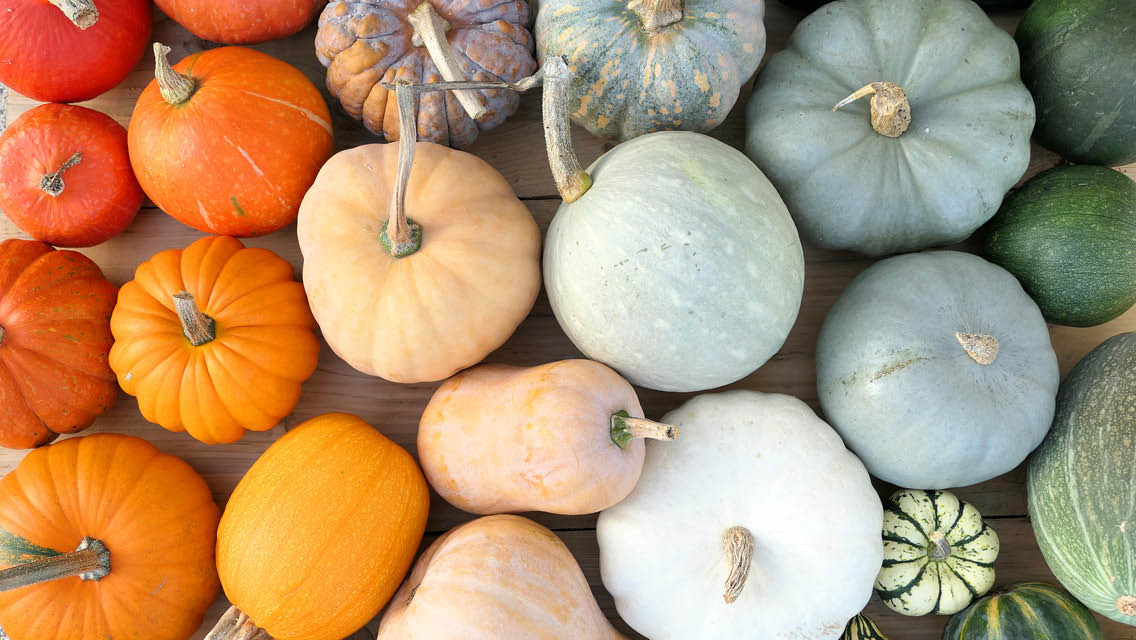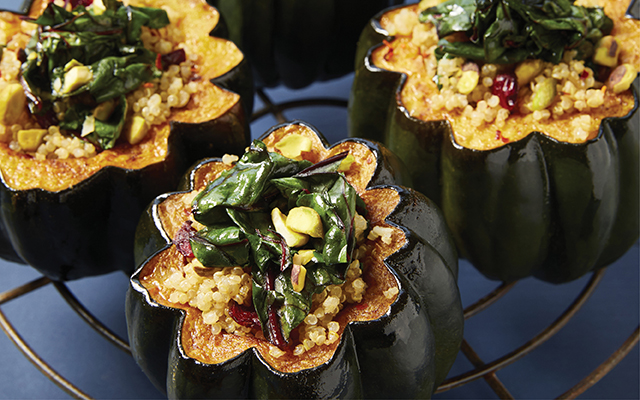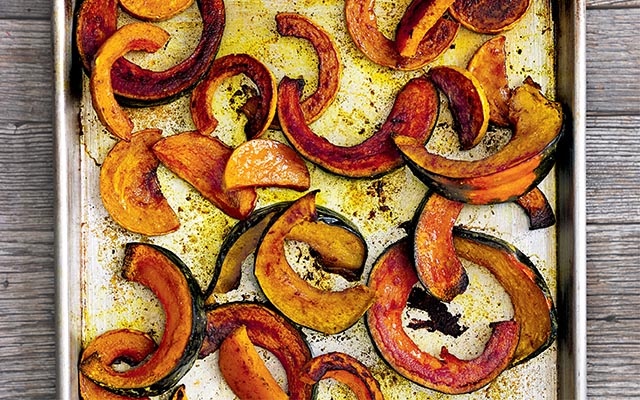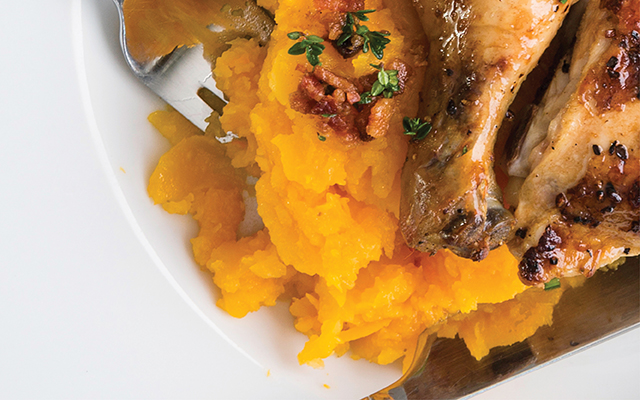I did not love squash as a child. In fact, as a young man, I despised it. But then I didn’t like Miles Davis, Akira Kurosawa movies, regular season pitching duels, Henry James, or 19th-century American art, either. And I grew to love them all.
For me, hard-shell winter squash, like so many other timeless classics, was an acquired taste, but now it’s one I can’t let go of. I mourn a little when it passes out of season, and miss it when it’s not around. But with vegetables, as with fruits, it’s the seasonal waiting that makes the tasting so sublime, and for me, the first squash of the early fall ranks right up there with the first berries of summer. So autumn is reason to celebrate!
Squash cooks up with a forgiveness that most other vegetables lack. It is adaptable to any cooking treatment, and when it comes to historic pedigree, squash may have no rival in the vegetable kingdom.
Edible Evolution
Squash is one of the world’s oldest known cultivated foods – a native to North America, prized by indigenous peoples from Canada to Chile, and the eternal fascination of European botanists and horticulturists. The majority of the world’s 132 most popular cultivars are native to Mexico. Some have been farmed for more than 15,000 years.
Squash classification reminds me of The Godfather movies – it’s a story of families. Instead of the Corleones, Barzinis and Tattaglias we have the Maximas (Hubbard and Buttercup), Mixta (Cushaws, Silver Edge and so on), Moschata (Butternut, Calabaza, most pumpkins) and Pepo (acorns and most summer squash). There are five domesticated squash varietals and roughly 20 wild ones that are most prevalent in the modern food world.
Today, squash is loosely divided into summer and winter varieties. The dividing line between the two corresponds more to differences in use than between botanical species of the Cucurbita family. Winter squash can be stored long term when fully mature on the vine. The skins are very hard. Summer squash is picked when immature on the vine and has a short-term, post-harvest life span. Summer squash is quick cooking; winter squash is not. The flavor of winter squash is infinitely more complex than its summertime cousins, though. After all, really, who can truly say they “love” the unadulterated taste of something as bland and unassuming as a zucchini?
Hale and Hearty
Nutritionally speaking, mature squash is a treasure trove – loaded with vitamins, minerals and complex carbohydrates, but low in fat and calories. The most significant dietary contribution comes from unusually high concentrations of carotene, a precursor of vitamin A. You’ll find 90 percent of the RDA of vitamin A, 16 percent of vitamin C and 12 percent of potassium in just half a cup of cooked winter squash.
Cancer-fighting compounds like flavonoids, sterols and monoterpenes all abound in squash. The seeds, however, have the very highest concentrations of all these healthful benefits. They contain 35 percent protein, and are also high in potassium, phosphorous and magnesium.
Squash can be roasted whole, in halves or in pieces; stuffed; fried (it makes a great tempura); grilled and brushed with sweet glazes; boiled or steamed for sautéing or mashing, or cooked by just about any other means you can conceive.
Aborigines simply rolled their squashes into the coals of a dying fire and ate them when soft. The Sioux of the Dakotas sliced and skewered squash on willow branches and dried them over open fires. One Massachusetts Indian treat was the precursor of the Colonial pumpkin pie: whole winter squash, decapitated and stuffed with dried fruit, nuts, spices and milk, then baked in – you guessed it – a fire.
Because I am guessing you don’t have a smouldering bonfire on hand just now, I suggest you try the recipe for squash gnocchi below. Serve it to some friends you care deeply about (even ones who’ve never much cared for vegetables), and then tell me if any of you will ever look at or feel about squash the same way again.
Thoughts on Squash
- Buy firm and blemish-free winter squash, then store in a very cool, dark place. It will keep all winter.
- Peel flat-skinned winter squash with a paring knife, ribbed winter squash with a large serrated knife.
- Cooked and puréed winter squash can be frozen long term without detriment.
- Grind toasted seeds for seasoning chili or molés and baked goods like breads and muffins.
- Try slicing and grilling winter squash, brushing with yakitori glaze (buy ready-made or make your own from sake, tamari, rice wine and ginger) before taking off the grill.
- Purée any winter squash and season with maple syrup and bourbon, pie spices or curry spices.
- Sauté cubed winter squash as you would potato hash browns and season with onions and rosemary.
- Try to get your hands on some Japanese Kabocha squash. It has an easy-to-peel turban shape and may be the tastiest and sweetest of all winter varietals.
- Spaghetti squash, invented in 1930, can be baked and the strands of flesh scraped from the skin, then seasoned to taste. Its unusual flesh stands up well to baking in a gratin with tomatoes, thyme and Romano cheese.
Squash Gnocchi
(makes 7 to 8 dozen pieces)
- 1 1/2 lbs. russet potatoes
- 2 lbs. cubed winter squash (acorn, butternut, silver edge, etc.)
- 1 egg
- 2 egg yolks
- 1/2 cup ricotta cheese
- 1 bulb roasted garlic
- 2 tbs. minced parsley
- 3 cups all-purpose flour, plus a little more on hand
Directions
- Preheat an oven to 300 degrees. Place the garlic bulb in a small ovenproof container and roast for 2 hours. Remove and let rest at room temperature. Cut the top off the bulb and squeeze out the roasted garlic, mash with a fork and reserve.
- Clean and prick the skin of the potatoes. Turn the heat up to 350 degrees and place the potatoes into an ovenproof container and cook until done (50-60 minutes). Remove at once, cut in half, scoop out the potato flesh and pass through a ricer or food mill into a large work bowl.
- Steam the squash over a medium boil until tender (approximately 15 minutes), then pass through a food mill. Add the potatoes, 3 tbs. of roasted garlic, the ricotta, parsley, egg and egg yolk.
- Add 2 cups of the flour and mix quickly using two or three forks held in your hand, let the fork tines “pull” the dough into a pile of small clumps. Add flour a little at a time until dough holds together when pinched. You may have to increase the amount of flour depending on the moisture content of your squash.
- Gather dough into ball and let rest for several minutes. Roll out onto a floured work surface and cut into fifths, roll each piece by hand into a long hot-dog shape, then cut rolls into 1 1/2 inch slices using a pastry-bench knife.
- Freeze on a sheet pan and bag for later use, or cook in rapidly boiling salted water until dumplings float for 60 seconds.
- Drain and serve.
- Serving suggestion: Try tossing the gnocchi in browned butter seasoned with fresh sage leaves, minced parsley, a pinch or two of lemon zest and some diced tomato (for visual contrast). Garnish with Parmesan Reggiano.





This Post Has 0 Comments